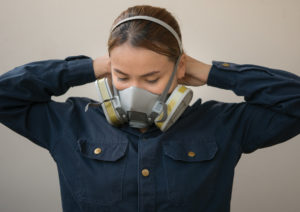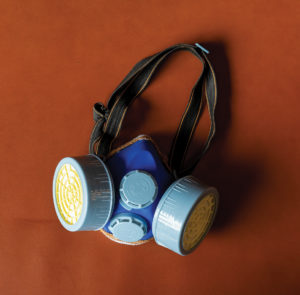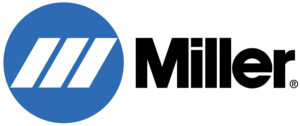Respiratory Protection: OSHA’s 1910.134
“The purpose of the OSHA Respiratory Protection Standard 29 CFR 1910.134 is to provide a guideline in establishing an effective, written respiratory program. Where engineering controls are not feasible or are not sufficient to maintain compliance, respirators are an effective method of protection when properly selected and worn. Currently listed as #3 on OSHA’s Top 10 most frequently cited violations, over 2,629 businesses were cited for respiratory protection violations in 2020. Providing a clean and compliant workplace doesn’t need to be complicated. Following OSHA’s standard allows you to establish and implement an effective respiratory program. Miller offers respiratory and weld fume solutions when exploring considerations within the OSHA Hierarchy of Controls, helping to ensure that your workplace safety is maximized and compliance is maintained.” – Kathi Abshire, Welding Safety Solutions Manager, Miller Welding, www.millerwelds.com
History/Background

© phuangphech – stock.adobe.com
OSHA’s Respiratory Protection Standard 29 CFR 1910.134 applies to general industry, construction, shipyards, marine terminals and longshoring. In keeping with many of OSHA’s other standards, 1910.134 identifies engineering controls as the primary means of limiting employees’ exposure to a workplace hazard—in this case, airborne contaminants.
When engineering controls aren’t feasible, respirators must be provided to employees, free of charge. A respirator is a protective facepiece, hood or helmet that is designed to protect the wearer against a variety of harmful airborne agents. Respirator selection depends upon the hazards to which the worker is exposed (i.e., insufficient oxygen environments, harmful dusts, fogs, smokes, mists, gases, vapors and sprays). These hazards may cause cancer, lung impairment, diseases or death.
Why Standard is Important
Respirators protect the user in two basic ways: by removing contaminants from the air or by supplying clean, respirable air from another source. The first category includes particulate respirators that filter out airborne particles and air-purifying respirators with cartridges/canisters, which filter out chemicals and gases. In the second category are airline respirators, which use compressed air from a remote source, and self-contained breathing apparatus (SCBA), which include their own air supply.
OSHA estimates that compliance with its respiratory standard could avert hundreds of deaths and thousands of illnesses annually.
Key Compliance Requirements

© memorystockphoto – stock.adobe.com
OSHA requires employers to implement and maintain a respiratory protection program that will be overseen by a qualified program administrator. In addition to respirators, the program must also provide employees with training on how to use the respirators and medical evaluations. Respirators used must be certified by the National Institute for Occupational Safety and Health (NIOSH). OSHA specifies the types of respirators approved for “immediately dangerous to life or health” (IDLH) atmospheres and for non-IDLH atmospheres.
Employers must identify and evaluate the respiratory hazards in the workplace, including a reasonable estimate of employee exposures and identification of the contaminant’s chemical state and physical form. Where exposure cannot be identified or reasonably estimated, the atmosphere shall be considered immediately dangerous to life or health (IDLH).
A medical evaluation must be conducted by a physician or other licensed healthcare professional (PLHCP) in order to determine an employee’s ability to use a respirator. The employer must obtain a written recommendation regarding the employee’s ability to use the respirator from the PLHCP.
Additional medical evaluations are required under certain circumstances, i.e., if an employee reports medical signs or symptoms related to respirator use; or changes occur in workplace conditions that might substantially increase the physiological burden on an employee.
All employees using a tight-fitting, facepiece respirator must pass a fit test prior to initial use and at least annually thereafter. The employer must provide for the cleaning and disinfecting, storage, inspection and repair of respirators used by employees. The cleaning and disinfecting must be done before being worn by different individuals (if a respirator is issued to more than one employee) and after each use for emergency use respirators and those used in fit-testing and training.
Resources:
- To view the complete standard, go to www.osha.gov/laws-regs/regulations/standardnumber/1910/1910.134
- For many articles on this topic, go to IHW’s website (https://industrialhygienepub.com/) and type “respiratory protection” into the search box.
FAQs
Here are some of the frequently asked questions OSHA addresses on a document available on its website (https://tinyurl.com/y9bn4zbc).
Q: Why is a formal respirator program needed?
A respirator program increases the chances of using a respirator correctly. A respirator will only protect if it is used correctly.
Q: What can be done if an employee has an unusual face size and has trouble being fit-tested for
a respirator?Manufacturers make several different sizes. Respirators may also vary in size from manufacturer to manufacturer. Users may be able to get a better fit by trying a respirator made by another manufacturer. In some cases, the use of powered air-purifying respirators may be appropriate. Employers must help employees find a suitable respirator.
Q: Can a respirator be used by more than one person? How often should it be cleaned and disinfected?
Disposable respirators cannot be disinfected and are therefore assigned to only one person. Disposable respirators must be discarded if they are soiled, physically damaged or reach the end of their service life. Replaceable filter respirators may be shared, but must be thoroughly cleaned and disinfected after each use, before being worn by a different person.
Share on Socials!
Choosing Dust Monitoring Equipment: A Delicate Balance
It’s Not Just Dust: Implementing a Respirable Crystalline Silica Training Program
Central Dust or Fume Collection System Triad
Leaders in Industrial Hygiene
Council for Accreditation in Occupational Hearing Conservation (CAOHC)
Subscribe!
Sign up to receive our industry publications for FREE!










